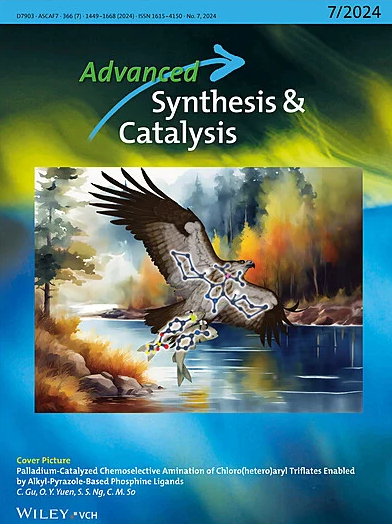烯烃的协同自由基Markovnikov加氢硒化反应
IF 4.4
2区 化学
Q2 CHEMISTRY, APPLIED
引用次数: 0
摘要
在此,我们报道了一种新的协同自由基马尔可夫尼科夫氢硒化烯烃的原位生成的硒团簇,在温和的条件下吸收氢化物。在该方案中,提出了一种正式的“金属氢化”机制,其中氢原子被添加到烯烃中,然后进行SH2自由基取代,得到以前无法获得的二烷基硒化物产物。这种不含金属的双硒烯反应使具有生物活性的硒原子能够顺利地安装到范围非常广的脂肪族和芳香族烯烃以及药物衍生的烯烃中,并具有高官能团相容性。本文章由计算机程序翻译,如有差异,请以英文原文为准。
Synergistic Radical Markovnikov Hydroselenization of Alkenes
Herein, we report a new synergistic radical Markovnikov hydroselenization of alkenes by in‐situ generated selenium cluster that absorbs hydride under mild conditions. In this protocol, a formal “metal hydride” mechanism is proposed, in which the hydrogen atom is added into the alkene, then undergoing SH2 radical substitution to give the dialkyl selenides products that previously are inaccessible. This metal‐free double selenium‐ene reaction enables smoothly the installation of the bioactive Se atom into a remarkably wide scope of aliphatic and aromatic alkenes and pharmaceuticals‐derived alkenes along with high functional groups compatibility.
求助全文
通过发布文献求助,成功后即可免费获取论文全文。
去求助
来源期刊

Advanced Synthesis & Catalysis
化学-应用化学
CiteScore
9.40
自引率
7.40%
发文量
447
审稿时长
1.8 months
期刊介绍:
Advanced Synthesis & Catalysis (ASC) is the leading primary journal in organic, organometallic, and applied chemistry.
The high impact of ASC can be attributed to the unique focus of the journal, which publishes exciting new results from academic and industrial labs on efficient, practical, and environmentally friendly organic synthesis. While homogeneous, heterogeneous, organic, and enzyme catalysis are key technologies to achieve green synthesis, significant contributions to the same goal by synthesis design, reaction techniques, flow chemistry, and continuous processing, multiphase catalysis, green solvents, catalyst immobilization, and recycling, separation science, and process development are also featured in ASC. The Aims and Scope can be found in the Notice to Authors or on the first page of the table of contents in every issue.
 求助内容:
求助内容: 应助结果提醒方式:
应助结果提醒方式:


